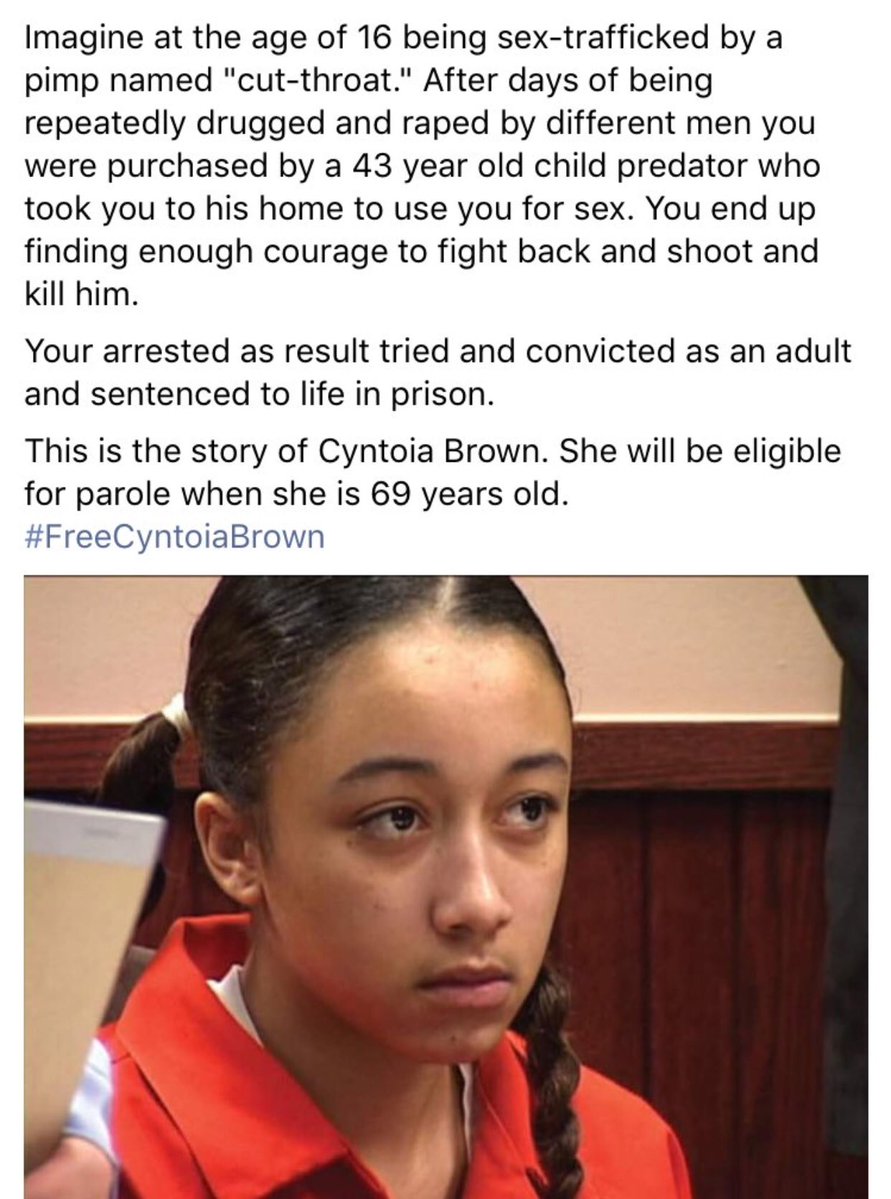Cyntoia Brown and Legal Challenges in Sex-Trafficking Cases
One of the outstanding injustices and human cruelties drawn to our attention this semester was the matter of young girls who are sex-trafficked, in the US as well as internationally. This was especially palpable in a documentary entitled “A Path Appears,” a documentary examination by NYT journalist Nick Kristoff of the impacts of poverty on women, including US sex trafficking (Nicholas Kristoff and Sheryl Wudunn, 2015, 270 minutes). Trafficked women frequently have experienced extensive amounts of background youth trauma, and sexual, emotional and physical abuse; and traffickers also tend to go after the most vulnerable women and girls, particularly those who are young, depressed, addicted, alone, insecure, homeless, and impoverished. The women’s involvement in the sex trade subjects them to further physical, sexual and emotional abuse; makes them more likely to become addicted to drugs and alcohol; and heavily increases their vulnerability to contracting sexually-transmitted diseases. Moreover, as the law frequently targets those selling sex rather than those buying it, trafficking often quickly involves the women in the CJ system, as offenders, something that further blights their future opportunities for extraction from the trade, work, housing and education.
Recently, the case of a 24-year-old woman, Cyntoia Brown, has drawn national attention to girls who are sex trafficked in the US, and their individual tragedies. Brown’s case was brought to national attention by a tweet from Kim Kardshian, following Daniel Birman’s 2011 PBS documentary of her case, “Me Facing Life: Cyntoia’s Story” (http://www.pbs.org/independentlens/films/me-facing-life/). Cyntoia, who was pimped by a man named “Cut Throat” in Tennessee when she was 16-years-old, was tried and convicted for first-degree murder in 2006, and sentenced to life after shooting to death a 43-year-old man who had picked her up for sex (she admitted to the shooting). She is eligible for parole after 51 years (at age 68). Kardashian offered to find Cyntoia legal support to fight her appeal, though this is unlikely to be effective: her case is currently at the PCR stage (Post-Conviction Relief), having already been denied on appeal. PCR cases are notoriously difficult to win, and conviction vacations in first-degree murder cases are incredibly rare. Cyntoia was defended by 2 public defenders, one of whom had extensive homicide trial experience. Her background of extensive childhood trauma – including physical and sexual abuse – was argued by her lawyers in her defense. Like many states, Tennessee permits life-sentences for teens who are convicted of first-degree murder, and Cyntoia’s case came to the bench prior to the 2012 Miller v. Alabama decision, which prohibits mandatory life sentencing of juveniles in homicide cases, although it could be retrospectively reviewed under those criteria.
One of the tragedies of trafficked women in the justice system is that the law has no provisions for such cases. A review of the PCR documents in the case show that the evidence was clearly present for a conviction (unlike how the media have portrayed it). The victim, Allen, picked Brown up at a hotel for sex, and offered for her to sleep at his home. When they returned to his home, he showed Cyntoia some guns in his possession, and proceeded to try to have intercourse with her. Waiving her Miranda rights during interview, Cyntoia claimed his behavior of reaching beneath the bed made her fearful that he would shoot her, so she shot him with a handgun she had in her purse. However, according to court documents, Allen was found shot in the back of the head, lying face down, his hands interlocked beneath him, without defensive wounds. His truck had been stolen, along with his money, and two of his guns. When the police located his vehicle, this led them to Cyntoia, who was arrested at a hotel with her pimp, “Cut Throat” (https://www.scribd.com/document/365102446/Cyntoia-Brown-court-documents#download). Allen was killed with a gun that did not belong to him, and Cyntoia had admitted to shooting him.
While forensic psychology speaks to why a young, traumatized girl like Cyntoia, who was being trafficked and effectively abused by both her pimp and her clients, might kill a man for her pimp (an inference which could be drawn from the facts of the case), the law has no provisions for a trauma-motivated murder. The definition of first-degree murder depends upon “thinking and doing,” and it is not hard to see how a jury could have construed Cyntoia’s behavior as “thinking and doing.” The women who killed for Manson were convicted on the same basis, irrespective of their background of trauma and abuse and brainwashing by Manson. The law acts on the supposition that a person acts on their own initiative and judgment, and has a an understanding of “reasonable behavior” (unless they are insane, a legal bar rarely effective in front of a jury, even in clear cases of immense mental impairment), and hence is responsible for their own actions. There is no provision for how a person’s judgement may be influenced by their past and present trauma, and hence the case of Cyntoia Brown – who is very likely to remain in prison, despite her lawyer’s arguing for the influence of Fetal Alcohol Syndrome in the impairment of her judgment – shows the great challenge of recognizing the reality of trauma and circumstance in legal judgements.
